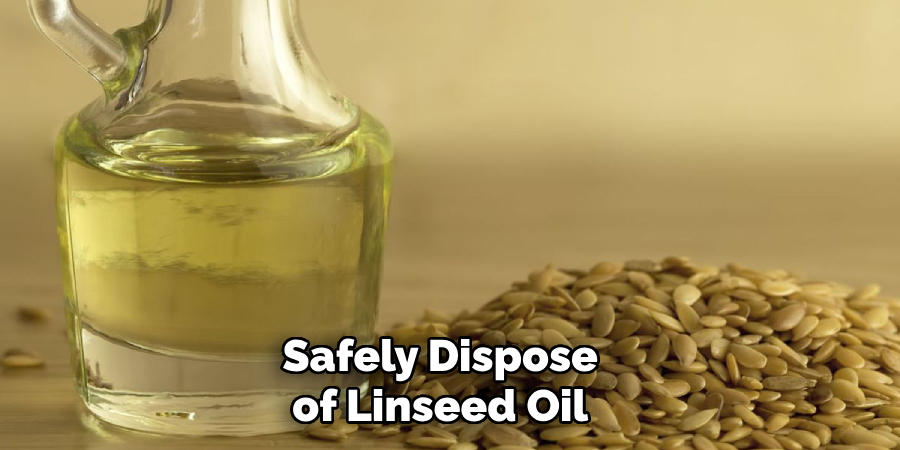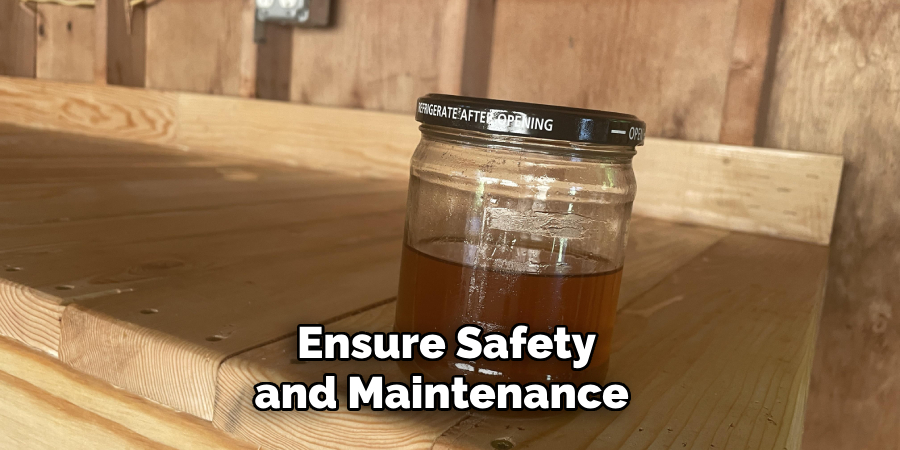Linseed oil, derived from the seeds of the flax plant, is a versatile substance commonly used in woodworking, painting, and as a finish for various surfaces. Its properties as a drying oil make it an ideal choice for creating durable and protective coatings. However, the disposal of linseed oil poses significant environmental and safety concerns.

Improper disposal can lead to environmental pollution and create fire hazards due to the risk of spontaneous combustion. Therefore, it is crucial to understand how to dispose of linseed oil safely and responsibly. This article aims to provide a comprehensive guide on the best practices for disposing of linseed oil, ensuring that users are informed and equipped to handle this substance in an environmentally conscious manner.
Understanding Linseed Oil
What is Linseed Oil?
Linseed oil is a natural oil extracted from the seeds of the flax plant (Linum usitatissimum). Rich in alpha-linolenic acid, it functions as a drying oil due to its ability to polymerize and form a solid film when exposed to air. This property makes it an excellent choice for applications such as wood finishes, in which it enhances the appearance and durability of the surface, as well as in paints, where it acts as a drying agent and improves adhesion.
Environmental and Safety Concerns
The disposal of linseed oil presents significant environmental impacts; if not managed correctly, it can lead to soil and water contamination. Additionally, used linseed oil can create serious safety hazards due to the risk of spontaneous combustion from dried rags and residues.
This risk becomes more pronounced if these materials are improperly stored or disposed of. Moreover, the fumes emitted from linseed oil can pose health risks, particularly in poorly ventilated areas, making it imperative to adhere to safe disposal practices to minimize these risks and protect the environment.
Preparing for Disposal
Assessing Quantity and Condition
When preparing to dispose of linseed oil, it’s essential to assess both the quantity and condition of the oil you have on hand. For small amounts of used linseed oil, you can safely and responsibly manage disposal by soaking it up with absorbent materials, such as paper towels, and allowing it to dry in a well-ventilated area away from direct sunlight. Once dried, these materials can typically be disposed of in the regular trash as long as local regulations permit.

For larger quantities, however, special considerations are necessary. Proper storage is crucial; store unused oil in original, sealed containers in a cool, dry place, and never mix it with other substances. Larger quantities of used linseed oil should be taken to a hazardous waste facility or a local collection program, ensuring that the disposal method complies with local environmental regulations.
Safety Precautions
Taking safety precautions is vital when handling linseed oil and its residues. To avoid spontaneous combustion, ensure that rags and materials soaked with linseed oil are placed in a metal container with a tight-fitting lid or thoroughly dried before disposal. This practice minimizes the risk of ignition from the heat generated during the drying process.
Additionally, it’s important to utilize personal protective equipment (PPE) when handling linseed oil. Wearing gloves minimizes skin contact, while masks can help protect against inhalation of fumes. Always work in a well-ventilated area to further reduce health risks. Prioritizing these safety measures will protect individuals and the environment during disposal.
How to Dispose of Linseed Oil: Disposal Methods
Household Disposal Options
There are several viable methods for safely disposing of linseed oil in a household setting. First, check if your local hazardous waste program allows for household collection events. Many communities organize these events regularly, providing residents with a convenient opportunity to dispose of hazardous materials, including linseed oil, without worrying about legal ramifications or environmental impacts. If your community offers this service, be sure to collect any remaining linseed oil and verify the event’s schedule and location.

Another option is to explore your municipal waste collection services. Some municipalities have specific guidelines for disposing of liquid waste, including linseed oil. It’s essential to refer to your local waste management authority or the municipal website to determine if they accept linseed oil through regular curbside pickup. If they do not, placing it in your normal trash is usually a violation, and proper disposal methods must be followed to prevent environmental contamination.
Recycling and Reuse
Recycling linseed oil can be a sustainable choice, reducing waste and promoting an eco-friendly approach. First, recycling facilities should be located in locations that accept oil-based substances. Some specialized recycling centers may have the capacity to purify and reuse linseed oil, ultimately transforming it into a valuable resource instead of contaminating the environment. Research local recycling programs, as many cities have begun to embrace green initiatives.
Moreover, creative reuse options for leftover linseed oil should be considered. While it is not advisable to use it on food-preparation surfaces or in areas where it might pose health risks, leftover linseed oil can serve numerous purposes. For instance, it can be used to condition wooden furniture, restore wooden tools, or treat wooden garden stakes. By exploring non-toxic ways to repurpose this oil, you can contribute to sustainability efforts while utilizing what remains after your projects.
Professional Disposal Services
Hiring professional disposal services may be the most responsible choice for larger quantities or complicated disposal situations. Numerous companies specialize in managing and disposing hazardous materials, including linseed oil. These companies are trained to handle the complexities associated with hazardous waste disposal, ensuring that stringent regulations are followed. If you are uncertain about handling leftover linseed oil, hiring professionals can ensure that proper care is taken throughout the disposal process.
The benefits of relying on these specialized services extend beyond compliance with legal requirements. Professional disposal companies are equipped with the necessary equipment, knowledge, and regulatory know-how to prevent environmental damage. They often provide documentation of the disposal process, which can be beneficial if you require proof for commercial applications or personal records. Engaging with hazardous waste disposal professionals fosters responsible management practices while protecting your interests and the environment.
Handling and Storing Linseed Oil
Safe Storage Practices
Proper storage practices for linseed oil are crucial to ensure safety and maintain its quality. First, always use appropriate containers when storing linseed oil. Opt for original, sealed containers to prevent exposure to air and contaminants. If transferring the oil, use containers made from materials that are compatible with oil, such as glass or specific plastics, and ensure they are airtight. Additionally, labeling these containers is essential. Clearly mark each container with information stating its contents and include warning labels to inform anyone handling it of potential hazards.

When it comes to storage conditions, linseed oil should be kept in a cool, dry place, away from direct sunlight and any sources of heat, such as stoves or radiators. This helps to prolong the oil’s shelf life and minimizes the risk of it reaching its flash point. Adequate ventilation in storage areas is also important, as it helps to dissipate any vapors that may accumulate, further reducing hazards.
Handling Rags and Residues
Handling rags and residues from linseed oil requires particular attention to prevent fire hazards. After use, rags or absorbent materials soaked in linseed oil should never be left out in the open, as they can spontaneously combust. To safely manage these rags, place them in a metal container with a tight-fitting lid immediately after use. This prevents oxygen from fuelling a potential fire. Ideally, the rags should be fully dried out before disposal if possible, significantly lowering the risk of ignition.
In the event of a spill, prompt action is required. Use absorbent materials like paper towels to soak up the spill, followed by proper disposal methods. After soaking, dispose of the used towels in accordance with local hazardous waste guidelines or place them in the designated metal container until evaluated for disposal.
Legal and Regulatory Considerations
Local Regulations
Understanding local regulations for hazardous waste disposal is essential for compliance and environmental protection. Each municipality may have specific guidelines for managing linseed oil and other hazardous materials. For instance, local waste management authorities often outline accepted disposal methods and the proper categorization of such waste.
Failing to adhere to these regulations may result in legal penalties. It’s crucial to check the specific requirements for your area, which may include designated collection days or the use of specific disposal sites. Additionally, certain municipalities may require reporting to document the disposal, particularly if large quantities are involved. Always maintain any necessary documentation to confirm compliance with local laws.
Federal Guidelines
At the federal level, the Environmental Protection Agency (EPA) has established regulations governing the disposal of hazardous materials, including linseed oil. These guidelines are vital in ensuring safe and responsible waste management practices nationwide. The EPA classifies waste oils as hazardous and subject to stricter handling and disposal requirements.
Some of the regulations require proper identification, storage, and treatment of hazardous waste to mitigate environmental impacts. The EPA’s website provides comprehensive resources for those seeking further guidance, including regulatory details, program contacts, and best practice recommendations. Engaging with these resources can help ensure both compliance and the promotion of environmental stewardship while managing linseed oil and other hazardous materials.

Conclusion
In summary, understanding how to dispose of linseed oil safely is crucial for both environmental protection and personal safety. Proper disposal methods, whether through professional services or adherence to local regulations, are essential in managing hazardous materials responsibly. It is vital to implement safe storage practices and handle rags and residues correctly to mitigate the risk of spontaneous combustion and environmental harm.
By following these safety precautions and disposal methods, individuals can ensure compliance with legal requirements and contribute to broader ecological conservation efforts. Ultimately, embracing responsible management of linseed oil and other hazardous substances is not just a regulatory obligation; it is a step towards fostering a safer, cleaner environment for all. Therefore, always remember the importance of proper disposal practices to protect our surroundings and prioritize safety in every step of the disposal process.
About the Author
Adrian Green, a lifelong woodworking enthusiast, shares his passion for the craft through The Woodenify Blog. With a foundation built on years of hands-on experience in his father’s woodworking shop, Adrian is dedicated to helping others learn and grow in the world of DIY woodworking. His approach to woodworking combines creativity, practicality, and a deep appreciation for the art of building with your own hands. Through his blog, he inspires individuals of all skill levels to embark on their own woodworking journeys, creating beautiful, functional pieces of furniture and décor.
Professional Focus
- Specializes in DIY woodworking projects, from furniture to home décor.
- Provides step-by-step guides and practical tutorials for woodworkers of all skill levels.
- Dedicated to helping readers build confidence and skill through easy-to-follow instructions and tips.
- Passionate about fostering a community of makers who can share, learn, and grow together.
Education History
- University of Craft and Design – Bachelor of Fine Arts (BFA) in Woodworking and Furniture Design
- Woodworking Apprenticeships – Extensive hands-on training with skilled craftsmen to refine carpentry and furniture making techniques.
- Online Courses & Masterclasses – Continued education in advanced woodworking techniques, design principles, and specialized tools
Expertise:
- DIY woodworking, carpentry, furniture making, and home décor projects.
- Creating accessible tutorials and guides for beginner to advanced woodworkers.
- Sharing the joys and satisfaction of woodworking, from raw materials to finished products.
